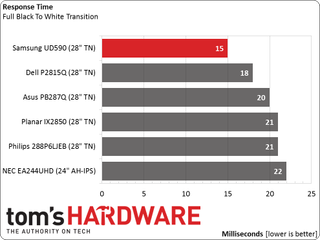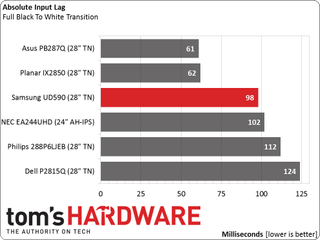Samsung U28D590D 28-Inch Ultra HD Monitor Review
Why you can trust Tom's Hardware
Results: Viewing Angles, Uniformity, Response, And Lag
To learn how we measure screen uniformity, please click here.

As mentioned on page three, the U28D590D has five options under the Samsung Magic Angle menu for improving off-axis image quality. Believe it or not, the settings do improve the image, as advertised. This is accomplished by altering the display’s gamma to emphasize some of the detail that’s normally lost when looking at a TN monitor from the side or above. They don't help with the horizontal color shift, however. That will still be greenish no matter what option you choose.
Our photo was taken with the feature turned off. Light falloff, color shift and detail retention are about the same as the other monitors based on the 28-inch TN Ultra HD Innolux panel.
Screen Uniformity: Luminance

TN-based panels are not known for great black field uniformity, but the U28D590D emerges as the second TN monitor in our group to drop below the 10-percent mark in this test. Even the IPS-based NEC can’t quite get there. According to our luminance meter, the brightest spot is in the center of the screen. But you won’t see that in practice.
Here’s the white field measurement:

The white field uniformity result is even better, beating the other TN screens. Samsung again makes sure the hotspot occurs in the center, where it’s the least noticeable.
Screen Uniformity: Color

Our sample U28D590D shows a slight color error down the left side of the screen. You can’t see it without a meter though. This is one discipline where modern TN panels really improve over their predecessors. It’s difficult to find a display with objectionable field uniformity these days and our results support that.
Pixel Response And Input Lag
Please click here to read up on our pixel response and input lag testing procedures.

We performed these tests with Game Mode both off and on. Panel response is the same either way at a rapid 15 milliseconds. Of all the displays in the group, the U28D590D has the least motion blur, though the effect is pretty subtle across the board. Any of the monitors look pretty good showing video and movie content.
Here are the lag results:

Since this monitor class is a go-to for gaming, input lag becomes a real differentiator when it comes time to choose a budget-friendly Ultra HD screen. Unfortunately the U28D590D doesn't quite break into the top group. Ninety-eight milliseconds is the result with Game Mode turned on. When it’s off, lag is a little greater at 106ms. Either way, gamers needing immediate response to control inputs should look at the Asus or Planar displays. Samsung has everything else going for it except this one attribute. If you’re more of a casual player (like me), the other specifications make it more than suitable for recreation.
Current page: Results: Viewing Angles, Uniformity, Response, And Lag
Prev Page Results: Color Gamut And Performance Next Page Samsung U28D590D: A Solid ChoiceStay on the Cutting Edge
Join the experts who read Tom's Hardware for the inside track on enthusiast PC tech news — and have for over 25 years. We'll send breaking news and in-depth reviews of CPUs, GPUs, AI, maker hardware and more straight to your inbox.

Christian Eberle is a Contributing Editor for Tom's Hardware US. He's a veteran reviewer of A/V equipment, specializing in monitors. Christian began his obsession with tech when he built his first PC in 1991, a 286 running DOS 3.0 at a blazing 12MHz. In 2006, he undertook training from the Imaging Science Foundation in video calibration and testing and thus started a passion for precise imaging that persists to this day. He is also a professional musician with a degree from the New England Conservatory as a classical bassoonist which he used to good effect as a performer with the West Point Army Band from 1987 to 2013. He enjoys watching movies and listening to high-end audio in his custom-built home theater and can be seen riding trails near his home on a race-ready ICE VTX recumbent trike. Christian enjoys the endless summer in Florida where he lives with his wife and Chihuahua and plays with orchestras around the state.
-
mgilbert Correction - I wound up with R=49, G=33, B=48. And this monitor is blindingly bright. I have brightness set at 40, contrast at 60, and sharpness at 52.Reply -
Charly2nd "If you want a 32-inch jumbo screen to anchor your high-end rig, you’ll still pay between $1500 and $2000."Reply
This is not true anymore. Benq and Acer bith sell 32inch IPS panels for under U$D1000. Also, Dell' has a 27 inch 4K IPS panel that sells for 700 dollars, but can be found regularly for U$D 500 during promotions. So, there are cheaper IPS options out there (I purchased one for U$D 524 - hasn't arrived yet), almost for the same price of these TN panels. -
airborn824 I have this monitor and i enjoy it, i got it for free. I Would buy the ASUS if it was my own money. Does anyone know if this is also getting Freesync support? I have 2x R9 290Reply -
Charly2nd My correction aside, I like the thoroughness of Christian's reviews. I come often to this site because of hardware reviews like these! Thanks!Reply -
Grognak Eh, TN on such a massive, 4K monitor is kinda counterintuituve. It's true that they're getting better when it comes to both viewing angles and colors, but that's still not quite IPS quality here. Also, the 98ms input lag is insane, most TVs don't go that high. I guess you can't be too demanding at that price.Reply -
Ilander The Amazon link to the PB287Q links to the incorrect product, mistakenly leading me to believe that it was 399.99 USD. That's a huge difference in price which really sets a person's opinion on value...please fix.Reply -
xj97 I had this monitor at work and ended up pawning it off on someone else. The panel was pretty decent, but it did NOT play well with sleep states over displayport. The monitor wouldn't wake up... I'd have to pull the power plug to reset the darn thing.Reply
Other than that I loved it, but the sleep issue was just too annoying. -
ceberle Reply15156989 said:I have this monitor, and am wondering why you tested it on HDMI, which only yields a 30 Hz refresh rate. Would using the DisplayPort input change any of the numbers significantly, especially considering that there is no option to change the black level when on DP? Would using DP affect input lag?
Also, I found the green level much too high out of the box, and my old HueyPro calibrator agreed. I wound up with R=49 G=43 B=48. And, using a couple of gamma test images, I found gamma to be way off. I used the QuickGamma utility to correct it. With these corrections, I have excellent image quality.
When I test monitors with the Accupel signal generator it is indeed over HDMI but since the input resolution is 1920x1080, the tests are run at 60Hz. I have made comparisons of HDMI and DisplayPort with regards to response and input lag and found no difference in speed. Resolution also makes no difference since the panel scales any incoming signal to its native resolution.
-Christian-
-
qlum Looking at these screens I think my upgrade to 4k for my primary monitor is going to wait a while longer. Especially since my 4 screen setup would require a vesa mount.Reply
